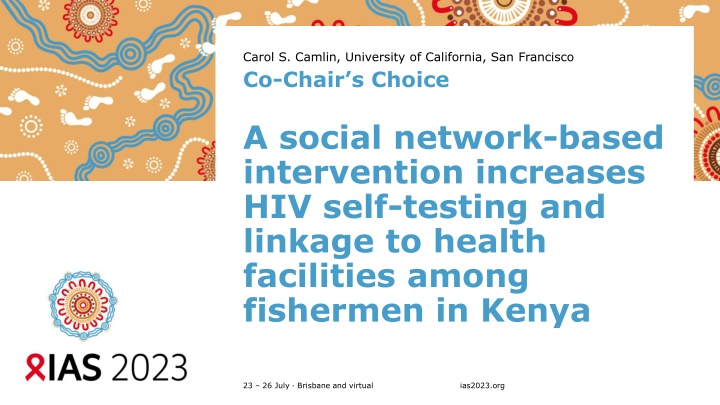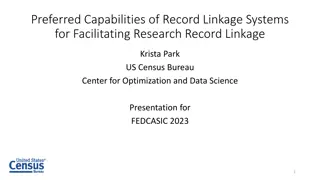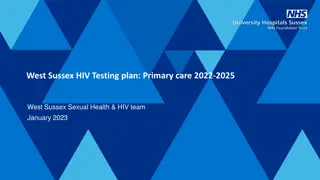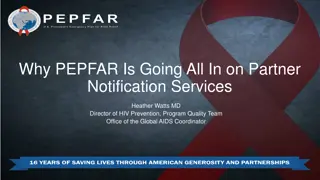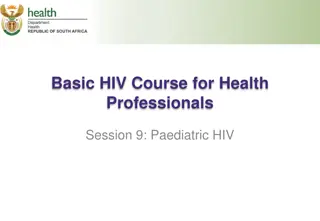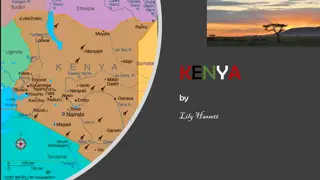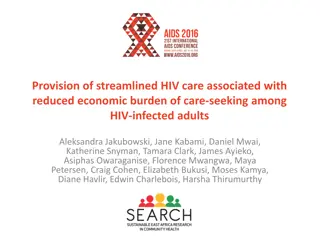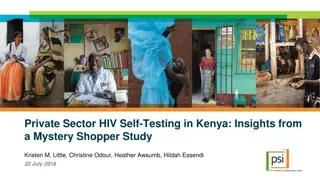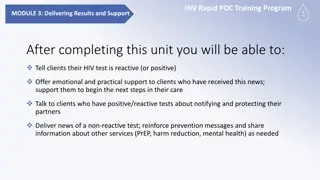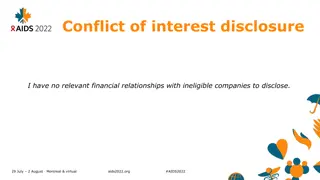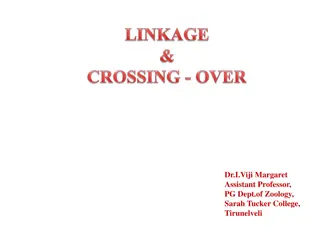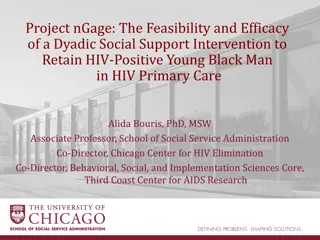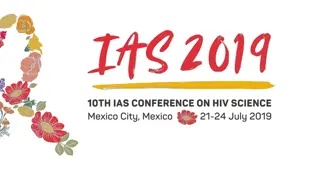Social Network-Based Intervention Improves HIV Testing and Linkage Among Fishermen in Kenya
In sub-Saharan Africa, a study was conducted among Lake Victoria fishermen in Kenya to assess the effectiveness of a social network-based intervention in improving HIV testing and linkage outcomes. Results showed significantly higher rates of HIV self-testing and linkage to health facilities in the intervention group compared to the control group. This innovative approach has the potential to engage hard-to-reach populations of men in testing, prevention, and treatment, addressing the challenge of low uptake of HIV services among highly mobile individuals.
Download Presentation

Please find below an Image/Link to download the presentation.
The content on the website is provided AS IS for your information and personal use only. It may not be sold, licensed, or shared on other websites without obtaining consent from the author.If you encounter any issues during the download, it is possible that the publisher has removed the file from their server.
You are allowed to download the files provided on this website for personal or commercial use, subject to the condition that they are used lawfully. All files are the property of their respective owners.
The content on the website is provided AS IS for your information and personal use only. It may not be sold, licensed, or shared on other websites without obtaining consent from the author.
E N D
Presentation Transcript
Carol S. Camlin, University of California, San Francisco Co-Chair s Choice A social network-based intervention increases HIV self-testing and linkage to health facilities among fishermen in Kenya 23 26 July Brisbane and virtual ias2023.org
Summary What is our main question? In sub-Saharan Africa, many men are unaware of their HIV serostatus, and highly-mobile men like Lake Victoria fishermen have particularly low uptake of testing, prevention and treatment. Our study sought to determine if an HIV status-neutral, social network-based approach could improve testing and linkage outcomes among fishermen in Kenya. What did we find? Self-reported HIV testing via self-tests at three months was significantly higher in intervention compared to control clusters of men s close social networks (60% vs. 10%, p<0.001, intent-to- treat). Following testing, linkage to facility for HIV treatment or PrEP was also significantly higher in intervention compared to control clusters (70% vs. 17%, p<0.001). Why is it important? This social network-based, status-neutral intervention in Kenya improved HIV testing and linkage outcomes among highly mobile men. It shows a promising way to engage hard-to-reach populations of men in testing, prevention and treatment. 23 26 July Brisbane and virtual ias2023.org
Study Rationale Ending the AIDS epidemic in eastern and southern Africa requires further engagement of men in HIV testing, prevention, and treatment The target of over 95% of people living with HIV knowing their HIV status has not been met by any country in the region (UNAIDS 2022) Men are more likely than women to be unaware of HIV status Engaging men remains challenging: Men are less likely to utilize facility-based health services Highly mobile men (e.g., working in fishing communities) have especially low uptake of HIV testing and linkage to ART or PrEP * Image from World Bank
Rationale & Setting Siaya County borders Lake Victoria and has a population of ~ 1 million, with ~79 beaches and 38,000 fisherfolk Transmission risks remain high in fishing communities in Kenya HIV incidence: 4.6-6.9/100 PY (2018)a HIV prevalence: 9.5-19.1% (2022)b Mobility & transactional sex economy (jaboya) contribute to high HIV risks a Borgdorff MW, et al. HIV incidence in western Kenya during scale-up of antiretroviral therapy and voluntary medical male circumcision: a population-based cohort analysis. Lancet HIV. 2018;5(5):e241-e249. b National AIDS and STI Control Programme (NASCOP). Kenya Population-based HIV Impact Assessment 2018: Final Report. Nairobi: NASCOP; August 2022.
Rationale for intervention strategies HIV self-testing (HIVST)bridgestesting gap, but more work needed on strategies for optimal distribution of self-tests and post-test linkage Social network-based approaches can leverage the power of social influence Selecting highly socially connected men within social networks to act as promoters may overcome barriers to HIV testing and health services Low-cost financial incentives can further increase linkage to care and prevention
Study Aims Aim 1: Increase men s HIV testing via secondary distribution of HIV self-tests Aim 2: Improve linkage to care and prevention among men who test for HIV Aim 3: Test the impact of interventions on ART or PrEP retention and adherence Outcome: Self-reported HIV testing uptake within 3 months Outcomes: Linkage to ART/PrEP within 3 months after self- reported HIV testing; Initiation of ART/PrEP (among those eligible), within 3 months of confirmatory testing (linkage) Outcomes: Viral suppression (HIV RNA <400 c/mL) at 6 months; Adherence to PrEP (TFV levels of >=1500 ng/mL in urine = adequate adherence) at 6 months
Methods Cluster randomized controlled trial Unit of randomization: clusters of close social networks of fishermen randomized 1:1 Three beach communities in Siaya County, Kenya selected on basis of size, non-contiguity, local leadership support to participate Eligibility: male aged 18 years, working as a fisherman or fisheries-related occupation Participants recruited using Beach Management Unit (BMU) registry, which documents name & contact information of individuals registered to work at a given beach Study team updated BMU registries, then screened, recruited, and enrolled eligible men who gave informed consent to participate 23 26 July Brisbane and virtual ias2023.org
Network Central Promoters Promoter Selection: Beach Social Network Mapping: (multiple name generating domains, across 7 relation types including money matters, emotional support, co-work in fishing, leisure and relaxation, health matters, etc.) Rapid Social Network Analysis: Selected highly socially connected men within social networks Promoter Roles: General HIV testing and treatment promotion HIV Self-Testing instruction and support (intervention) Linkage support Follow-up and check-in Promoter Training: HIV infection and transmission basics PrEP and ART (effectiveness, availability, eligibility) HIVST (procedures, results interpretation, linkage)
Intervention & control conditions 3-month 6-month Baseline PROCEDURES INTERVENTION Enhanced training (HIV basics, HIVST, PrEP, and ART) X X X HIVST for distribution via network-central promoters X X Voucher for cash redemption 500 KSH (at clinic linkage) X X Enhanced promoter support/training X X X Retention support via SMS/phone X X CONTROL Basic training (HIV basics and facility access/info) X Voucher for HIV test or HIVST redemption at facility X X Standard of care for ART or PrEP X X
Primary outcomes Outcomes Defined as Analytic approach HIV self-testing uptake Proportion of participants who report using the self-test kits at the 3-month follow-up visit Cluster adjusted Pearson s Chi- square test HIV testing via blood-based test or HIV self-test Proportion of participants who report any modality of HIV testing (whether counsellor-administered or HIV self-test) at the 3-month follow-up visit Proportion of individuals from whom clinic received their promoter- distributed voucher upon linking Multilevel mixed-effects logistic regression with cluster-adjusted standard errors Linkage to study-affiliated public health facilities
STUDY ENROLLMENT Eligible population 2,478 fishermen Screened 1,523 Completed Social Network Mapping 1,509 Mapped & randomized 778 members 156 cluster central leads 934 Baseline survey 88% retention of fishermen from baseline to three month follow up 596 members 137 cluster central leads 733 Midline survey 496 original members 29 new members 141 cluster central leads 15 deaths 666
Characteristics of participants Intervention (374) Control (359) Overall Age (median, range) 36.0 (19.7, 77.2) 38.5 (20.4, 82.3) 37.2 (19.7, 82.3) Marital Status Married Unmarried but partnered Single/divorced/widowed Education Primary or less Some/all secondary >Secondary Polygynous marriage a 320 (85.6%) 15 (4.0%) 39 (10.4%) 306 (85.2%) 15 (4.2%) 38 (10.6%) 626 (85.4%) 30 (4.1%) 77 (10.5%) 259 (69.4%) 93 (24.9%) 21 (5.6%) 66 (20.6%) 241 (67.3%) 97 (27.1%) 20 (5.6%) 72 (23.5%) 500 (68.4%) 190 (26.0%) 41 (5.6%) 138 (22.0%) a Among married men
Fig. 1: Self-reported HIVST in ~<3 months 100 90 80 70 Percentage 60 50 40 30 20 10 p<0.001 0 Intervention Control Tested Did not Test
Fig. 2: Self-reported HIV testing (HIVST or facility-based testing) in 3 months 100 90 80 70 Percentage 60 50 40 30 20 10 p<0.001 0 Intervention Control Tested Did not Test
Fig. 3: Linkage to health facility 100 90 80 70 Percentage 60 50 40 30 20 10 p<0.001 0 Intervention Control Linked Did not link
Conclusions A social network-based, status-neutral intervention in Kenya improved men s HIV testing and linkage outcomes and is a promising way to engage men in prevention and treatment. HIV interventions can harness the power of social networks to diffuse new information, skills, and behaviors in communities. Supporting men to engage other male friends in prioritizing their health can change social norms and facilitate men s uptake of health services. Social network-based approaches may be especially helpful for engaging mobile populations in treatment and prevention. 23 26 July Brisbane and virtual ias2023.org
Thanks and Acknowledgements Funding Support: This research was supported by the U.S. National Institute of Mental Health, R01MH120176 (Camlin, Thirumurthy) and K24MH126808 (Camlin). Registered NCT# 04772469. Authors: Carol S. Camlin1,2, Lila Sheira3, Zachary A. Kwena4, Edwin D. Charlebois2, Kawango Agot5, James Moody6, Benard Ayieko5, Sarah A. Gutin7, Antony Ochung5, Phoebe Olugo5, Jayne Lewis-Kulzer1, Holly Nishimura2, Monica Gandhi2, Elizabeth A. Bukusi4, and Harsha Thirumurthy8 1 Dept. of Obstetrics, Gynecology & Reproductive Sciences, UCSF, U.S. 2 Department of Medicine, UCSF 3 Dept. of Epidemiology & Biostatistics, UCSF 4 Kenya Medical Research Institute (KEMRI), Kisumu, Kenya 5 Impact Research & Development Organization (IRDO), Kisumu, Kenya 6 Duke University, U.S. 7 Department of Community Health Systems, UCSF 8 University of Pennsylvania, U.S. We would like to thank Owete study participants, the Kenyan Ministry of Health, the Beach Management Units (BMUs), and IRDO staff who made this study possible. Contact: Carol Camlin, PhD MPH carol.camlin@ucsf.edu 23 26 July Brisbane and virtual ias2023.org
Abstracts from the Owete Study team at IAS 2023: Limited experience with HIV pre-exposure prophylaxis (PrEP) among fishermen in western Kenya: A qualitative analysis (Olugo et al., #3878) Hazardous alcohol use associated with higher risk sexual risk behavior among fishermen in a high HIV prevalence area of Kenya (Camlin, Charlebois et al., #4667) There is no need to leave the beach to test : A qualitative study of HIV self-testing knowledge, acceptability, and willingness to distribute HIVST kits among fishermen in western Kenya (Olugo et al., #1937) Associations between PrEP use, HIV risk behaviors, and perceived HIV risk among fisherfolk in Siaya County, Kenya: A cross-sectional multilevel analysis (Nishimura et al., #4837) Characteristics of male social networks of fishermen in three communities in a high 23 26 July Brisbane and virtual HIV prevalence region of Kenya (Moody et al., #3258) ias2023.org
